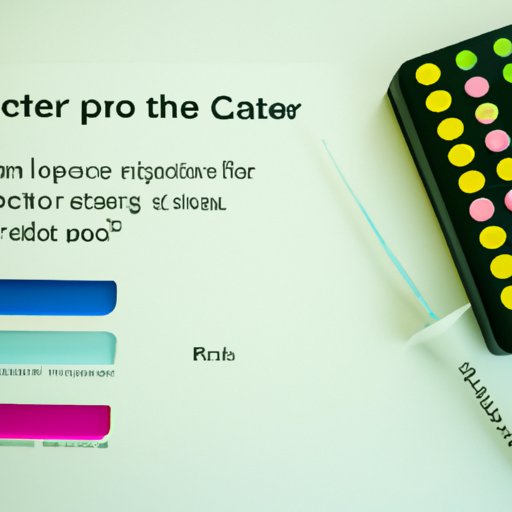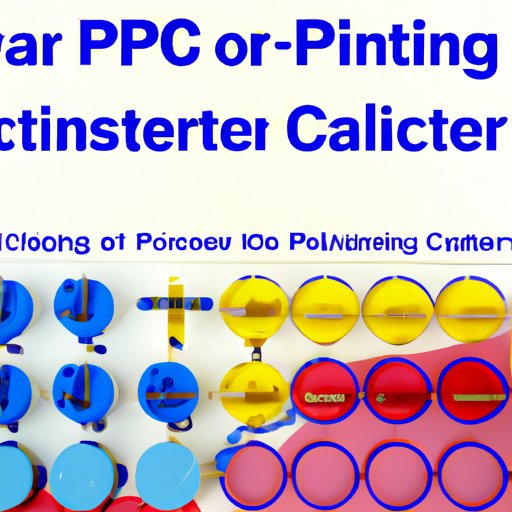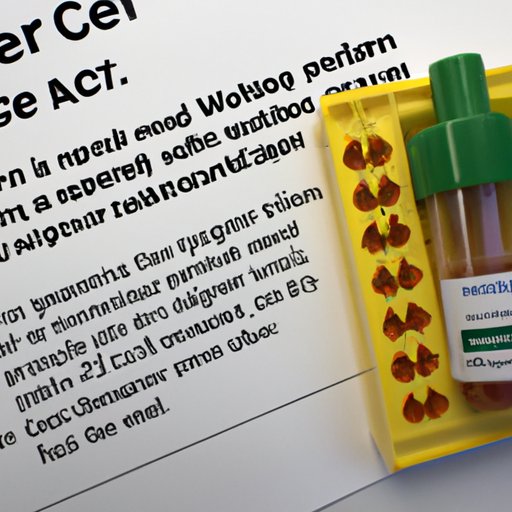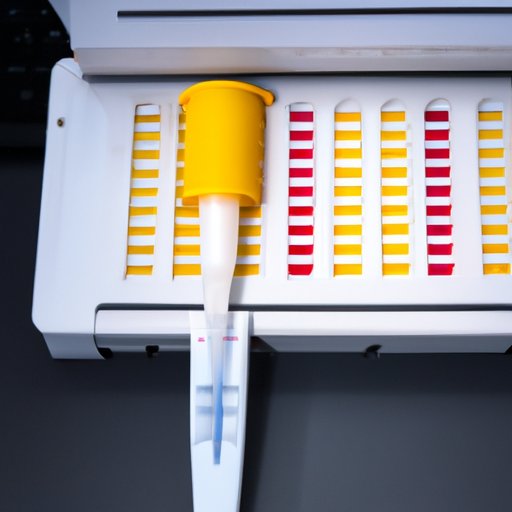Introduction
Polymerase chain reaction (PCR) testing is a method used to analyze DNA and detect the presence of specific genetic material. It is widely used in medical diagnosis, forensics, and research. In this article, we will explore the basics of PCR testing, how it works, and what it can tell us. We’ll also look at the science behind PCR testing, including the techniques and tools used, and what factors affect the accuracy and reliability of the results.
Explaining PCR Testing: A Step-by-Step Guide
PCR testing involves amplifying or copying a small section of DNA many times over. This allows scientists to study and identify specific pieces of genetic material. The process is broken down into several steps, each of which is necessary for a successful result.
Overview of the Process
The PCR process involves four main steps: denaturation, annealing, elongation, and amplification. During the denaturation step, the double-stranded DNA is heated to separate the strands. Next, during annealing, specific primers attach to the target DNA sequence. Then, in the elongation step, a special enzyme called DNA polymerase adds complementary bases to the primer-template complex. Finally, the amplification step replicates the target DNA sequence many times over.
Detailed Description of Each Step
The first step, denaturation, involves heating the sample to separate the two DNA strands. This typically takes place at 95°C for 15–30 seconds. Next, during annealing, the primers are added. Primers are short sequences of DNA that bind to specific regions of the target DNA sequence. The temperature is then lowered to allow the primers to bind to the target sequence. This typically takes place at 50–65°C for 20–40 seconds.
In the next step, elongation, the enzyme DNA polymerase adds complementary bases to the primer-template complex. This typically takes place at 72°C for 30–60 seconds. Finally, in the amplification step, the target DNA sequence is replicated many times over. This typically takes place at 72°C for 2–5 minutes.
The Basics of PCR Testing: What You Need to Know
PCR testing is a powerful tool for analyzing DNA and identifying specific genetic material. But what is it used for? How accurate is it? And what kind of samples can be tested? Here’s what you need to know.
What is PCR testing used for?
PCR testing is used in a variety of applications, including medical diagnosis, forensics, and research. It is widely used to detect viruses and bacteria, such as HIV, hepatitis, and tuberculosis. It is also used to diagnose genetic disorders, cancer, and inherited diseases. PCR testing is also used in forensics to identify individuals from biological evidence, such as blood, saliva, and hair samples.
How accurate is it?
PCR testing is highly accurate and reliable. According to a study published in the journal Clinical Chemistry, “The sensitivity of PCR testing is generally high, with sensitivities ranging from 97% to 100%.”
What kind of samples can be tested?
PCR testing can be performed on a variety of samples, including blood, saliva, urine, tissue samples, and swabs. It can also be used to detect genetic material in environmental samples, such as soil, water, and air.

PCR Testing: How It Works and What It Can Tell Us
Now that we’ve gone over the basics of PCR testing, let’s take a closer look at how it works, and what kind of results can be expected.
What happens during the testing process?
During the PCR process, a small section of DNA is amplified or copied many times over. This allows scientists to study and identify specific pieces of genetic material. The process involves four steps: denaturation, annealing, elongation, and amplification.
What kind of results can be expected?
PCR testing can provide detailed information about a person’s genetic makeup. It can detect the presence of viruses, bacteria, and other pathogens. It can also be used to diagnose genetic disorders and inherited diseases. In addition, PCR testing can be used to identify individuals from biological evidence, such as blood, saliva, and hair samples.
PCR Testing: Uncovering the Science Behind the Process
Now that we’ve looked at the basics of PCR testing, let’s take a closer look at the science behind the process. What is the science behind PCR testing? And what tools are used in the process?
What is the science behind PCR testing?
PCR testing is based on the principle of DNA replication. During PCR, a small section of DNA is amplified or copied many times over. This allows scientists to study and identify specific pieces of genetic material. The process involves four steps: denaturation, annealing, elongation, and amplification.
What tools are used in the process?
The PCR process requires several tools, including a thermal cycler, primers, nucleotides, and the enzyme DNA polymerase. The thermal cycler is used to heat and cool the sample to facilitate the binding of the primers. Primers are short sequences of DNA that attach to specific regions of the target DNA sequence. Nucleotides are the building blocks of DNA, and they are used to add complementary bases to the primer-template complex. Finally, the enzyme DNA polymerase catalyzes the synthesis of new DNA strands.
The Science Behind PCR Testing: What You Should Know
Now that we’ve looked at the tools used in PCR testing, let’s take a closer look at the techniques and factors that affect the accuracy and reliability of the results. What techniques are used in PCR testing? And what factors affect the accuracy and reliability of the results?
What techniques are used in PCR testing?
PCR testing involves several techniques, including denaturation, annealing, elongation, and amplification. During the denaturation step, the double-stranded DNA is heated to separate the strands. Next, during annealing, specific primers attach to the target DNA sequence. Then, in the elongation step, a special enzyme called DNA polymerase adds complementary bases to the primer-template complex. Finally, the amplification step replicates the target DNA sequence many times over.
What factors affect the accuracy and reliability of the results?
Several factors can affect the accuracy and reliability of the results. These include the quality of the sample, the concentration of the target DNA, the efficiency of the PCR reaction, and the type of primers used. Additionally, the accuracy of the results can be affected by contamination, cross-contamination, and errors in the PCR process.

PCR Testing: A Comprehensive Overview
Now that we’ve looked at the science behind PCR testing, let’s take a step back and look at the big picture. What are the benefits of PCR testing? And what are the limitations?
Benefits of PCR testing
PCR testing is a powerful tool for analyzing DNA and identifying specific genetic material. It is highly accurate and reliable, and it can provide detailed information about a person’s genetic makeup. It is also used in a variety of applications, including medical diagnosis, forensics, and research.
Limitations of PCR testing
Although PCR testing is a powerful tool, it does have some limitations. For example, it requires specialized equipment and materials, and it is time-consuming and labor-intensive. Additionally, PCR testing can only detect the presence of specific genetic material, and it cannot determine the amount or level of the target DNA.

Everything You Need to Know About PCR Testing
Now that we’ve looked at the basics of PCR testing and the science behind the process, let’s answer some of the most common questions about PCR testing. We’ll also provide some additional resources for learning more about PCR testing.
Common questions about PCR testing
Q: What is PCR testing?
A: PCR testing is a method used to analyze DNA and detect the presence of specific genetic material. It is widely used in medical diagnosis, forensics, and research.
Q: How accurate is PCR testing?
A: The sensitivity of PCR testing is generally high, with sensitivities ranging from 97% to 100%.
Q: What kind of samples can be tested?
A: PCR testing can be performed on a variety of samples, including blood, saliva, urine, tissue samples, and swabs.
Additional resources for learning about PCR testing
For more information about PCR testing, check out the following resources:
- CDC: PCR Testing
- Clinical Chemistry: The Sensitivity of Polymerase Chain Reaction
- WHO: Polymerase Chain Reaction (PCR) Testing for COVID-19
Conclusion
PCR testing is a powerful tool for analyzing DNA and detecting the presence of specific genetic material. It is widely used in medical diagnosis, forensics, and research. In this article, we explored the basics of PCR testing, how it works, and what it can tell us. We also looked at the science behind PCR testing, including the techniques and tools used, and what factors affect the accuracy and reliability of the results. Finally, we answered some common questions about PCR testing and provided additional resources for learning more about the process.
(Note: Is this article not meeting your expectations? Do you have knowledge or insights to share? Unlock new opportunities and expand your reach by joining our authors team. Click Registration to join us and share your expertise with our readers.)
